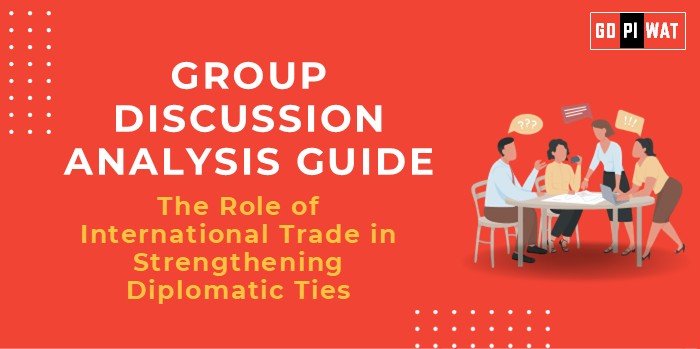📋 Group Discussion Analysis Guide: The Role of International Trade in Strengthening Diplomatic Ties
🌐 Introduction to the Topic
📖 Opening Context
International trade is not just a driver of economic growth but also a potent tool for fostering diplomatic ties. It has historically shaped alliances, resolved conflicts, and created pathways for mutual prosperity.
📜 Topic Background
The foundation of international trade lies in the exchange of goods, services, and resources across borders, creating interdependencies that encourage dialogue and cooperation. Organizations like the WTO and regional trade blocs like the EU highlight trade’s diplomatic role in conflict resolution and policy alignment.
📊 Quick Facts and Key Statistics
- 🌍 Global Trade Value: $32 trillion in 2022, illustrating trade’s massive global economic footprint (UNCTAD).
- 🤝 Bilateral Agreements: Over 450 free trade agreements in force worldwide, showing trade as a key diplomatic tool (WTO).
- 💰 Economic Dependency: 70%+ of global GDP linked to trade flows, reflecting its importance in international relations (World Bank).
- 🇨🇳🇺🇸 China-USA Trade: Bilateral trade worth $690 billion in 2022, despite political tensions.
🤝 Stakeholders and Their Roles
- 🏛️ National Governments: Establish trade agreements, set tariffs, and use trade as a diplomatic strategy.
- 🏢 Businesses: Drive cross-border investments, creating mutual economic interests.
- 🌐 International Organizations: Facilitate negotiations, resolve disputes, and ensure fair practices.
- 📢 Civil Societies: Advocate for sustainable and equitable trade practices.
🏆 Achievements and Challenges
✨ Achievements
- 🌍 Conflict Reduction: EU’s creation reduced intra-regional wars through economic interdependence.
- 🌎 Economic Synergies: USMCA ensures economic alignment across North America.
- 💡 Technology Transfer: Trade fosters innovation-sharing between nations, boosting global advancements.
⚠️ Challenges
- ⚔️ Trade Wars: US-China tensions show how trade disputes strain diplomacy.
- 🔗 Dependency Risks: Over-reliance on certain partners can threaten national security (e.g., Russian gas in Europe).
- ⚖️ Equity Gaps: Smaller nations often lack negotiation leverage, resulting in imbalanced agreements.
🌍 Global Comparisons
- ✅ EU vs. ASEAN: While the EU excels in integrating trade and diplomacy, ASEAN still faces challenges due to its diversity in governance systems.
📖 Structured Arguments for Discussion
- 🛠️ Supporting Stance: “Trade agreements like NAFTA have turned economic cooperation into diplomatic stability between nations.”
- 🛡️ Opposing Stance: “Trade imbalances can worsen relations, as seen in growing anti-China sentiments due to the trade deficit.”
- ⚖️ Balanced Perspective: “While trade strengthens ties, overdependence and mismanagement can strain diplomacy, requiring balanced policies.”
🎯 Effective Discussion Approaches
🔑 Opening Approaches
- 📊 Use trade statistics: “Global trade value reached $32 trillion in 2022, showcasing its vast diplomatic significance.”
- 📖 Cite a compelling case: “The EU’s role in preventing wars through economic interdependence highlights trade’s peace-building potential.”
⚙️ Counter-Argument Handling
- 🔄 “Although trade can strain relations, strong arbitration mechanisms like those in the WTO help resolve disputes.”
🧠 Strategic Analysis of Strengths and Weaknesses
SWOT Analysis:
- 💪 Strengths: Economic growth, conflict prevention, innovation-sharing.
- 🛠️ Weaknesses: Imbalances, dependency risks, resource exploitations.
- 🌟 Opportunities: Climate-focused trade, inclusive policies.
- ⚠️ Threats: Protectionism, geopolitical conflicts.
🏫 Connecting with B-School Applications
📚 Real-World Applications
- 🌍 Analyze trade’s impact on global operations and supply chains.
🎓 Sample Interview Questions
- ❓ “How does trade impact a nation’s foreign policy?”
- ❓ “Can free trade agreements address global inequality?”
💡 Insights for B-School Students
- 📈 Explore trade-related internships, such as working on ESG compliance in international supply chains.


